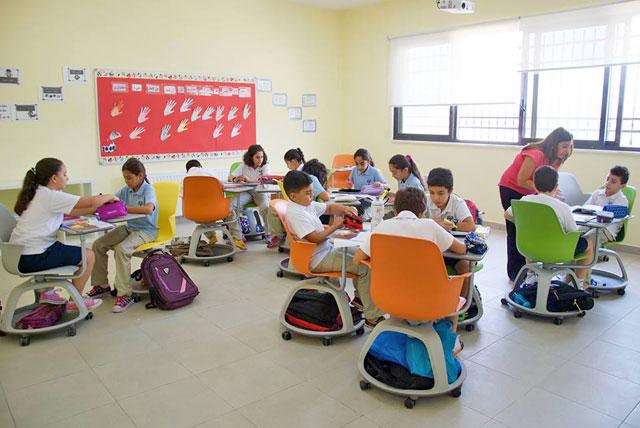You are here
Access all areas? Using data to disabled navigate cities
By Thomson Reuters Foundation - Apr 19,2018 - Last updated at Apr 19,2018

Photo courtesy of apple.com
BARCELONA — Entrepreneur Josep Esteba became so frustrated trying to get around his native Spain in a wheelchair for more than 20 years that he embarked on a mission to map cities for disabled people all over the world.
“Many years ago I travelled a lot for work, and would arrive in cities that I didn’t know very well,” he told the Thomson Reuters Foundation. “That’s when I realised that there just wasn’t information for those that needed it.”
Fast-forward several years and Esteba, a paraplegic since a car accident in his early twenties, set out on another journey — this time a virtual one to digitalise information on accessibility.
The 50-year-old, who founded the free mobile application Mapp4all in 2015, said such data had simply not existed in Spain.
The Barcelona-based app allows wheelchair users, as well as the blind, hearing-impaired and others, to find out how accessible a building is before they visit it.
Users can check whether a cinema or museum has ramps or lift access, for instance, or if a restaurant provides menus in Braille.
Establishments can register to add information themselves, but the app also draws on data that is self-reported by users. It has been downloaded in nearly 3,000 cities and works across nine languages.
Mapp4all is one of a slew of apps that have been developed in recent years to help disabled people navigate cities.
BlindSquare and Wayfindr both offer audio instructions to help blind people get around cities globally, while the Wheely NYC app helps New Yorkers use the subway by providing targeted information, like whether lifts are working.
Less opportunity
More than 1 billion people in the world have a disability, according to the World Health Organisation (WHO).
By 2050, of the roughly 6.25 billion people who will be living in urban areas, 15 per cent are expected to have disabilities, the United Nations Department of Economic and Social Affairs has predicted.
People with disabilities tend to have fewer economic opportunities and lower educational achievements than their able-bodied peers, due to a lack of tailored services and the obstacles they face in everyday life, according to the WHO.
Buildings without lifts, shops that have no step-free access and inaccessible toilets are just some of the challenges disabled people face in getting around urban areas.
In general, disabled people still do not expect places to be fully accessible, and there is a long way to go in quelling that anxiety, said Ross Atkin, a UK-based designer specialising in accessibility.
“When it’s somewhere they don’t know, they’re not sure there will be the drop curbs they need... they’re not sure they’re going to be able to get off the bus,” he told the Thomson Reuters Foundation.
“You only need a couple of experiences of going somewhere and getting stuck to lose your independent mobility,” he added.
Being better informed allows people to move out of their comfort zone, instead of going back to the same places they already know they can access, said Esteba.
Personal experience has taught him that accessibility data must be broad enough to cater for every type of user.
“I’m in a wheelchair, but what is accessible for me is not the same as for someone who is 30 years older or weighs 30 kilos more,” he said.
Varying needs
Managing varied needs — even among those with a similar disability — is a challenge in making cities more navigable, said Atkin.
Wheelchair users tend to report the same kinds of requirements, like unobstructed footways. But with sight loss, the problems are less obvious, and people’s requirements differ significantly, he said.
And solutions that work for someone with sight loss might be an obstruction for another person, he added.
Apps are helpful — but only if the information they provide is reliable, Atkin noted.
“If the app says there is going to be a drop curb and then there isn’t... you’re probably not going to trust the app again,” he said.
Silvia Guerrero, who has tried accessibility apps in Spain, said she found the data was often wrong or false when reported by the establishments themselves.
“This happened to me in a bank which said it was accessible, but at the entrance there was an insurmountable step for people in wheelchairs,” she told the Thomson Reuters Foundation. “I’ve come across this in several places.”
New data solutions
Experts say issues with data reliability, and friction between the needs of disabled users can be alleviated by new approaches to digital technology, such as a project known as Accessible Routes from Crowdsourced Cloud Services.
Led by University College London (UCL), it uses low-cost sensor devices on wheelchairs, linked to a mobile phone, to anonymously measure and collect data on how the chairs are used.
It removes the need to add a physical object to the environment that could get in someone’s way, or to rely on self-reported information, said Catherine Holloway, a lecturer in assistive technology and accessibility at the UCL Interaction Centre.
Within several years, it could provide a very large dataset for authorities to ascertain how accessible cities are and what works for disabled people in a more tailored way, she said.
The project, which has been piloted in India, provides much more dynamic data, and is economical as an existing WiFi network in a bus or metro can be used to transmit the data, she said.
The sensors were tested in Delhi last year under a programme called Street Rehab, in collaboration with local non-governmental organisations.
Researchers found disabled people in India’s capital had not been trained to use their wheelchair or tricycle, construction works often made roads impassable for them, and inaccessible infrastructure was a major barrier to them going to work.
“In the developing world, it really helps if there is already legislation in place to make infrastructure accessible — before it is built — so it doesn’t have to be retrofitted after construction, which is much more expensive,” Holloway said.
Around 80 per cent of people with disabilities live in developing nations, according to the United Nations Development Programme.
Experts say the poor are at higher risk of acquiring a disability due to lack of access to healthcare, sanitation and safe working conditions.
Cloud-based technology is also being developed by Irish start-up Pavanu Mobility, which develops robotic devices linked to mobile applications to spot potential accessibility hazards, and assess their seriousness.
Related Articles
AMMAN — With less than 10 per cent of wheelchair users in Jordan “actually” using their chairs to move around, rehabilitation professionals
TORONTO — In camps across northern Iraq, people forced from their homes by the Daesh extremist group militants are using their phones to tra
AMMAN — Despite an increasing number of initiatives implemented to raise awareness on accessibility for people with disabilities in Jordan,
















